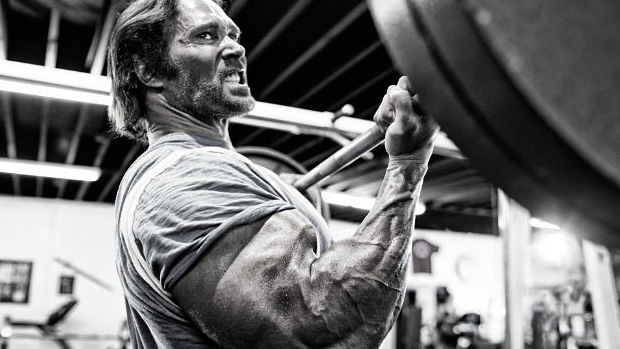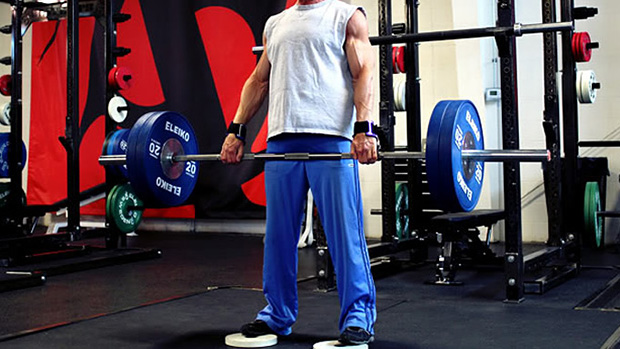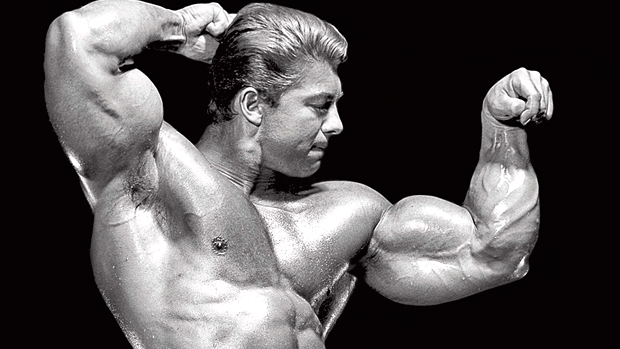Here's what you need to know...
- Paused reps increase time under tension. This is essential for hypertrophy. They push blood into target muscles, creating a massive pump.
- You'll use more intensity with less strain. Paused reps increase the difficulty of exercise without increasing the load. Less load means less stress on the joints.
- They'll improve your technique. Using mid-rep paused sets forces you to eliminate all momentum and helps perfect your form.
- Paused reps help eliminate sticking points. Even if you're only after strength gains, using paused reps will help you get stronger on specific lifts when used strategically.
Lift long enough and you'll run into plateaus. Then you can either keep spinning your wheels or drastically shake up your training and make progress. A new training stimulus can be just what you need to force your body to grow. Enter mid-rep pauses.
What Are Mid-Rep Pauses?
It's adding two pauses to each rep:
- One pause on the way up, at the halfway point
- One pause on the way down, at the halfway point
On the concentric (lifting) phase, you'll stop halfway through the rep for one second, then finish and contract the muscle as hard as you can. Then do another one-second pause at the mid-point on the eccentric (lowering) phase. Here's an example of what it looks like:
Hammer Curl With Mid-Rep Pause
Your form becomes nearly perfect, almost robotic, and exercises become significantly more challenging.
Why Do It?
- They increase the intensity of your lifts. Pausing extends the time under tension for a set and increases the mind-muscle connection. So you end up pushing a lot of blood into the muscle. This is especially helpful if you're wanting to activate a specific muscle that's become a weak link.
- They allow you to fatigue your muscles using less weight. Obviously it's important to get stronger, but if you can give your joints a break and effectively stimulate muscle growth with less strain on the body, that's a good thing. Seasoned lifters often battle cranky joints from years of heavy lifting. Having joint-friendly training options is an essential for long term training.
- They improve form and technique. When you pause your reps halfway through, you have to be focused and controlled throughout the entire movement. It's hard to use momentum with paused-rep training. When using other intensity techniques, such as traditional drop sets, it can be easy to start swinging your reps as fatigue sets in. While cheat reps have a place, it's best to use good form most of the time.
On compound lifts, such as deadlift and squat variations, pausing halfway through the rep will clean up your form. If you don't use control, you'll have a hard time with the pauses. It may be tempting to just push through a lift when it gets too heavy, but by stopping halfway you're forced to keep yourself honest and do it right.
How to Use Mid-Rep Pauses
If your goal is to build size, then it doesn't matter when you do your paused sets in the workout. And you can use them on compound lifts like the front squat or with isolation movements for muscles you want to grow. As strength isn't a primary goal, you have more options.
This isn't to say that mid-rep pauses limit your strength gains on compound lifts; you could use these pauses on all your sets and still get stronger. But since they're most useful for hypertrophy, I wouldn't recommend them on every compound set. You should still be training your main lifts with a normal tempo on a regular basis.
When doing mid-rep paused sets, aim for 6-10 reps on compound lifts and 8-15 on isolation movements. Regardless of your chosen reps, start with 50-60% of the weight you'd normally use as the intensity will be greater. On compound lifts, you don't want to be messing around with mid-rep pauses on heavy doubles or triples – stick with slightly higher reps.
If you're on a pure strength or powerlifting program, use these towards the end of your workout. The primary compound lifts of your program should be completed with a normal tempo. Use paused-reps for your assistance work. A powerlifter could use mid-rep pauses on the bench press to practice form or work on sticking points. However, he wouldn't completely stop normal bench pressing for extended periods of time.

Best Exercises for Each Muscle Group
This list will get you started on the exercises that work well for each muscle group, but feel free to experiment. Try mid-rep pauses on other exercises and you may find something you love.
Chest
- Dumbbell Press Variations: Dumbbell pressing is an exercise where form tends to break down with fatigue. Paused reps will fix that.
- Push-Up: The added intensity means a few higher-rep sets of push-ups can absolutely torch your chest at the end of a workout.
- Bench Press: Slowing down allows you to control your form and get the most out of your lift. Just don't bounce the bar off your chest and then try to stop it halfway.
Back
- Lat Pulldown: Another infamous swinging movement. Keep your torso completely rigid during these and really use your lats.
- Chest-Supported Row: This is a great option that eliminates momentum while supporting your back. Pendlay rows, or any other bent-over row, can fatigue your lower back trying to brace for so long. Use a machine or another variation that supports you.
- Inverted Row: Using your bodyweight may seem easy, but throwing in pauses makes it that much harder. I prefer inverted rows to chin-ups, as form is usually much better. If you're very good at pull-ups or chin-ups, however, you can try doing mid-rep pauses on those as well.
Legs
- Front Squat: You can get a very challenging training effect for your quads and core muscles using less weight. This makes the movement easier for some who may struggle to hold heavy weights in a front squat.
- Leg Extensions and Curls: Leg isolation machines are an excellent tool for quad and hamstring hypertrophy. Paused sets allow you to train with a high intensity and low weight, and as such, reduce the strain on your knees.
- Bulgarian Split Squat: Like front squats, this is another exercise that may challenge some new lifters who struggle to hold the weight. Paused split squats are brutal, but very effective.
Shoulders
- Seated Dumbbell Press: For paused-reps, seated dumbbell presses work better than military presses. They help you avoid stopping your lift during that mid-rep position where you may lean back or otherwise attempt to move your head.
- Machine Lateral Raise: Dumbbell lateral raises are okay, but you run the risk of fatiguing your arms before your delts. If you have access to a lateral raise machine you can completely isolate your delts.
Arms
- Barbell Curl: Any curl variation works. Mid-rep pauses put a stop to ego reps. Use lighter weights, control your form, and actually train your biceps. Don't do a standing hip-thrust to swing a weight you can't handle.
- Tricep Pushdown Variations: Paused reps work well for any pushdown variation. You can try them on dips or skull crushers, but you may end up straining your shoulders over your triceps. To completely isolate your triceps, use good old triceps extensions.
Workout Examples
The following workouts are designed for a lifter who wants to get bigger and stronger. You can adjust the specifics to fit your goals. This program includes both strength and hypertrophy work.
Before starting your compound sets, be sure to start light and ramp up to your working weight. Rest 2-3 minutes between your first two exercises. For the remaining exercises, rest 1-2 minutes or as needed.
"MRP" next to an exercise means that exercise is to be performed mid-rep paused style for the given number of reps.
Push Workout
| Exercise | Sets | Reps | |
|---|---|---|---|
| A | Bench Press | 4 | 6 |
| B | Military Press | 4 | 6 |
| C | Dip | 3 | 10 |
| D | Incline Dumbbell Press (MRP) | 3 | 12 |
| E | Dumbbell Lateral Raise | 3 | 15 |
| F | Tricep Rope Pressdown (MRP) | 3 | 12 |
Pull Workout
| Exercise | Sets | Reps | |
|---|---|---|---|
| A | Weighted Chin-Up | 4 | 6 |
| B | Pendlay Row | 4 | 6 |
| C | Straight Arm Pressdown | 3 | 12 |
| D | Wide Grip Lat Pulldown (MRP) | 3 | 10 |
| E | Plate Loaded Row (MRP) | 3 | 10 |
| F | Barbell Curl (MRP) | 3 | 10 |
Leg Workout
| Exercise | Sets | Reps | |
|---|---|---|---|
| A | Front Squat (MRP) | 4 | 8 |
| B | Sumo Deadlift | 4 | 6 |
| C | Reverse Lunge | 3 | 10/leg |
| D | Bulgarian Split Squat (MRP) | 3 | 8/leg |
| E | Lying Leg Curl (MRP) | 3 | 12 |
| F | Seated Calf Press | 3 | 15 |
When it comes to complex topics like training, there are things you know, things you don't know, and things you know but forgot how important they are. Here then, are six such reminders:
1. For most people, most of the time, your muscles will be fully recovered and ready to be trained again in two days.
That's right, muscle will be ready to train again in two days, which means if you wait any longer than this to hit that muscle again, you're losing ground.
It's not that "bro splits" (where you train each muscle group hard once per week) don't work, it's that they don't work as well as other approaches, at least for most people.
Now sure, if you happen to be Big Ramy or some other similarly huge lifter who regularly squats in the 700-800 range and benches north of 500, okay, maybe it takes your muscles a week to recover. The rest of us only need a day or two until we're ready to hit that muscle again, and if we don't, we'll start losing our previously-acquired gains.
Think of it this way: The bigger a muscle is, the more damage it sustains during training and the longer it'll take to recover from that damage. You probably already know intuitively that your biceps recover faster than your hamstrings, for example.
That being the case, most guys should train their bigger muscles (legs, back, and chest) 2-3 times per week, and their smaller muscles (pretty much everything else) 3-4 times per week.
This reality is the rationale behind my recommendation for 3 "whole body" sessions per week for most lifters. The best approach involves doing a squat, push, hinge, and pull movement, along with 1-2 optional movement for smaller muscles such as arms and calves, each workout.
2. Optimal training frequency is determined by optimal volume, not the other way around.
Sometimes when you're trying to improve your understanding of a concept, it helps to imagine the extremes, so let's apply that to training frequency.
If I were to suggest that you should only train once a week, you'd probably (and rightly) doubt my credibility, because that workout would probably take 4-6 hours, at least if you were trying to do enough work for every muscle group. So once a week is obviously a non-starter.
Now consider the opposite extreme: Imagine training 14 times per week. I guess the upside is that each workout would be super short, allowing you to impart maximum intensity into each training session, so there's that at least. But the obvious problem is that it hardly makes sense to drive to the gym twice per day for only a couple of sets.
Somewhere between these two extremes is the optimal training frequency, and this depends largely on how much total work you're doing each week. Put another way, if you need to do 16 sets for hamstrings each week in order for them to grow, you probably wouldn't train hamstrings once a week, but you also wouldn't train them 8 times a week. It turns out that 3-4 times per week tends to be the sweet spot for most lifters.
Bottom line, it's not frequency, but VOLUME that drives muscular growth, so simply use a frequency that makes it easiest to hit your optimal volume.
3. If you fail to enforce progressive overload, everything else you do is a waste of time.
Strangely enough, it takes a certain amount of muscle to lift a certain amount of weight. Funny how that works, right? Now, yes, I know beginners can get stronger largely by developing the neural aspects of strength production, but once you're past the novice stage, you won't get bigger until and unless you get stronger.
Most of us already understand the principle of progressive overload, but we're all prone to under-appreciating its importance in real world application, especially when those weights get heavy.
We often think we're progressing when we're not. Look back through your training journal and see if your weights for sets of 8-10 have improved on key lifts over the past few months. If they haven't, you haven't gained any appreciable muscle.
When your numbers get bigger, YOU get bigger, so know your benchmarks and make regular attempts to exceed them. As T Nation contributor Mark Rippetoe loves to say, "Hard and simple are the keys to big and strong."
4. While on a fat-loss diet, the best mass training program in the world suddenly becomes the best cutting program in the world.

I often bring up this point with female clients who have reservations about lifting making them too muscular, but it's a critical concept to understand for almost anyone who lifts.
There are a few "sub concepts" to this point. First, you can't gain muscle without extra calories, and you can't lose fat without "insufficient" calories, no matter how sound your training might be.
Secondly, when dieting/cutting, the entire point of lifting is to prevent or minimize the loss of muscle while enduring an energy deficit. So it only stands to reason that the best training to prevent muscle loss happens to be the same training approach you'd use for muscle GAIN.
If you've ever heard the phrase "you can't out-train a bad diet," this is largely what it means. Training and nutrition are like two sides of the same coin: Training creates the stimulus, and nutrition provides the energy for, and recovery from, that training.
5. You can use your strength levels on well-rehearsed "big" exercises as a good proxy for muscle mass.
Going back to point number three, once you've gotten past the novice stage, it takes a certain amount of muscle to lift a certain amount of weight – assuming that your technique doesn't change in your efforts to lift more weight.
Now, we all have an occasional "off" day due to poor sleep, stress, or other factors, but as a general trend, if you're getting stronger, you're gaining muscle. This isn't exactly a free and easy way to test your body composition, but it certainly helps let you know if you're gaining, losing, or maintaining your present degree of muscle mass.
6. You can do a lot less work for nearly the same benefit.
Italian economist Vilfredo Pareto might be one of the least-appreciated geniuses in history. His brainchild, The Pareto Principle states that for almost all endeavors and processes, 20% of the inputs lead to 80% of the outputs. Yep, this is the 80/20 rule.
In gym-practice, this simply means that doing one hard set provides roughly 80% of the benefit of 3-4 sets (give or take). Put another way, we're talking about the law of diminishing returns. Yes, each additional set leads to more benefit, but those benefits dwindle significantly with each new set.
If you cultivate a deep appreciation for this idea, it can come in really handy, especially when time and energy are in short supply. Just as an example, if you're short on time and high on stress, knowing that 1-2 hard sets is almost as good as 4-5 will encourage you to get in a quick workout rather than bailing out altogether.
Seek progress, not perfection.




